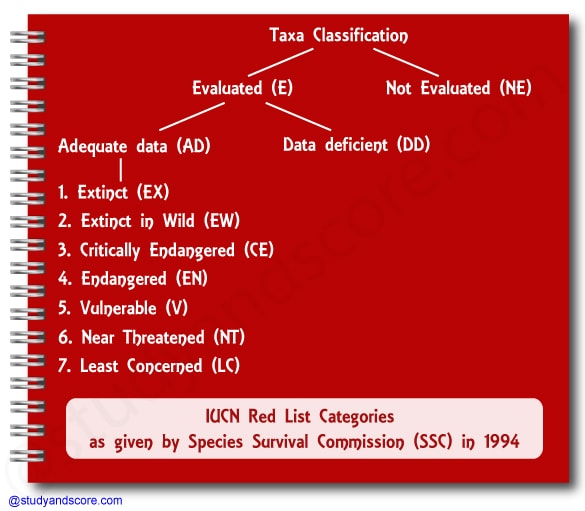Red data book is the international documented list of species whose continued existence is threatened. This list is preserved and updated by IUCN (International Union for the Conservation of Nature and Natural Resources). In the list, the species are classified into different categories based on supposed risk. Each Red Data Book deals with a specific group of animals or plants or fungi.
Actually, in the original IUCN Red Data Book, threat categories have been widely applied to thousands of taxa of animals, plants, and fungi. These categories refer to the conservation status of an organism in the wild and not to its existence in cultivation.
In 1994, IUCN revised Red data List categories which was reported and given by IUCN Species Survival Commission (IUCN SSC). These also include a series of criteria like decrease in population, range of occurrence, size of population of matured individuals, possibility of extinction etc. used to make the conservation assessment.
Red data list provides useful information on the threat status of the species. The red-listing assessment is a simple logical process to determine the threat status to a particular species based on available information.
The IUCN Red List Categories are aimed to be an easily understood system for classifying species at high risk of global extinction. The general objective of the system is to provide a clear framework for the classification of the species according to their extinction risk.
However, though the Red List may focus on the taxa at highest risk, it is not the sole means of setting priorities for their conservation measures.
The IUCN Red List Categories and Criteria have following aims:
Based on the evaluation, taxa can be of two types namely, “not evaluated taxa” and “evaluated taxa”
Not evaluated taxa (NE): Taxa are said to be not evaluated, if they are not yet been evaluated against any criteria.
Evaluated taxa (E): Taxa are said to be evaluated, if they are evaluated against some valid criteria.
Based on these criteria, Evaluated taxa (E) can be further grouped as data deficient taxa and adequate data taxa.
Data deficient (DD): Taxa are said to be data deficient if the information is inadequate for making any direct or indirect assessment about its risk of extinction. The biology of the taxa in this category may have been studied well but the data on its distribution may be lacking. Data deficient is not actually a threat category, but the taxa in this category require more information for deep research and further classification.
Adequate data taxa (AD): The taxa with adequate information for assessment and classification are grouped in this category. The taxa in this category are further classified into 7 categories as follows:
1. Extinct (EX): The taxa are categorized as Extinct (EX) when there is no doubt that the last existing individual has died. Before declaring a taxon as extinct, in-depth surveys in known and expected habitats at relevant seasons over a time frame appropriate to the taxon’s life cycle are performed. And if these surveys fail to record even a single individual, then the taxon is declared as Extinct.
2. Extinct in the wild (EW): The taxa are categorized as Extinct in the Wild (EW) when it is known to exist only in cultivation, domestication, captivity or as naturalized population outside the previous known geographic range. A taxon is supposed to be Extinct in the wild only after in-depth surveys in known and expected habitats fail to record even a single individual. These surveys must be performed at relevant seasons over a time frame appropriate to the taxon’s life cycle.

3. Critically Endangered (CR): The taxa are categorized as critically endangered (CR) when the evidences confirm that they meets any of the below given conditions,
4. Endangered (EN): The taxa are categorized as endangered (EN) when the evidences confirm that they meets any of the below given conditions,
5. Vulnerable (VU): The taxa are categorized as vulnerable (VU) when the evidences confirm that they meets any of the below given conditions,
6. Near Threatened (NT): The taxa are categorized as Near Threatened (NT) when it has been assessed against the criteria but currently do not qualify for Critically Endangered, Endangered or Vulnerable. But near threatened taxa are close to qualifying for any threatened category in the near future.
7. Least Concern (LC): The taxa are categorized as least concern when it has been assessed against the criteria but do not qualify for Critically Endangered, Endangered, Vulnerable or Near Threatened. Unlike near threatened taxa, these taxa do not have signs of qualifying for any threatened category in near future. Widespread and abundant taxa are included in this category.
The following are the rules for the transfer of taxa between categories:
A taxon may be moved from a category of higher threat to a category of lower threat,
The Red Data Book is the file for recording rare and endangered species of animals, plants and fungi. Even some local sub-species that exist within the territory of a state or country are recorded in red data books. Red data book gives important data for observational studies and monitoring programmes on habits and habitats of rare and endangered species.
India is the land known for rich biological diversity. It can be divided into ten bio-geographic regions. Till date India has documented about 91,000 species of animals and 46,000 species of plants. About 65,000 native local plants are used in ethnic health care. India is also known as one of the eight Vavilo’s Centers of Origin and Diversity of Crop Plants. In India we can find more than 300 wild ancestors and close relatives of cultivated plants which are still grown in natural conditions.
- Share with your friends! -
Login to post your comment here...
- or with social Account -